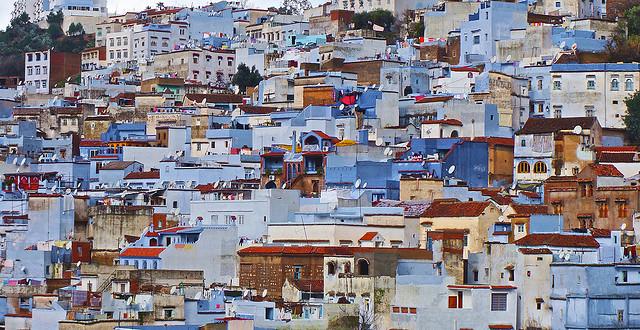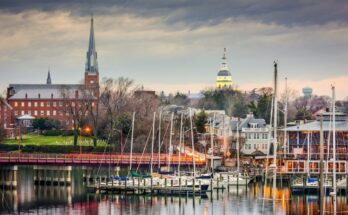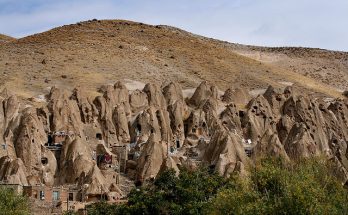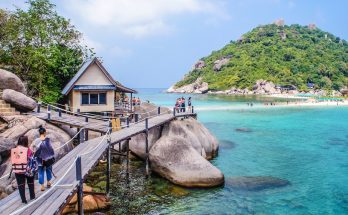When most people picture Morocco, they imagine vibrant, bustling markets and winding, narrow alleys littered with homes and shops. While Morocco is definitely known for chaotic old cities, it’s what lies beyond the walled gates that truly makes this northern African country so unique.
From the vast deserts of the Sahara to the windy seaside towns on the coast, Morocco’s landscape is one of the most diverse in the world. Throw in the imperial cities of Fez, Meknes and Marrakesh with their historic attractions and superb examples of early Islamic architecture, and you’ll understand why Morocco is a great travel destination.
With a long history, it has also developed a unique culture that ties ancient traditions together with modern growth. If you’re looking for some great things to do in Morocco, then look no further than list.
17. Bab Mansour Gate
Adorned in colorful mosaic tiles and inscribed with Arabic poems, the Bab Mansour is more than just a gate. It also happens to be one of the most ornate symbols of Morocco and an icon of classic Moroccan architecture. Completed in 1732, the Bab Mansour Gate guards the front of the Place El Hedim, a large square in the heart of old town Meknes.
Although you cannot walk through the grand doors of the gate, you can still admire its beauty from the square. One of the most notable features is the Arabic poem written over the arch. It translates to “I am the most beautiful gate in Morocco. I’m like the moon in the sky. Property and wealth are written on my front.”
16. Atlas Passes

With the wind in your hair and the open road in front of you, there’s nothing like a road trip through the Atlas Passes. On the way from Marrakech to the Erg Chigaga dunes, you’ll cross the Tizi n’Test pass. This winding road has a very steep incline, but you’ll be able to see the Moulay Brahim gorges, the charming town of Isni, and the valley of Ourigane.
Another option is to drive through the Tizi n’Tichka. The roads are equally as steep, but you’ll be rewarded with stunning views of the Atlas Mountains around every hairpin turn.
15. Asilah

Asilah, which lies on the northern tip of Morocco, is a fascinating seaside city with a predominately large Spanish influence. The white-washed buildings and plethora of Spanish restaurants is a reminder of when the city was part of Spanish Morocco, from 1912 until 1956.
The city dates back to 1500 BC, but many of the buildings are homes are from the 15th and 16th-century. The well preserved old medina and fortified seaside walls are two of the must-see attractions. The Grand Mosque of Asilah is also worth a visit; its unique white facade blends in seamlessly with the rest of the painted buildings in the town.
14. Telouet Kasbah

Tucked away in a small Berber village between Marrakech and the Sahara Desert is Telouet Kasbah. Built in the 18th and 19th centuries for the powerful El Glaoui family, Telouet Kasbah is a rare sight to behold. Adorned in colorful mosaics and red stucco, the kasbah had a strategic location on the caravan trail.
As one of the country’s most prominent figures, El Glaoui made a lot of money off olive, saffron, and salt trades from the kasbah. However, the rise of Moroccan independence proved difficult for the family, and El Glaoui was killed in 1953. The kasbah was eventually abandoned and sits in ruins today.
13. Cascades d’Ouzoud

The lush, cascading waterfalls of Ouzoud are a must-see during your trip to Morocco. Located near the Moyen Atlas village, the Cascades d’Ouzoud is a collection of several waterfalls that flow into the El-Abid River gorge.
The views from the top and the bottom of the falls are equally spectacular. You can start at the top and walk down to the summit of the falls, passing by different photo opportunities and lookouts along the way. You’ll also find several restaurants and cafes at the bottom, all with beautiful views of the Cascades d’Ouzoud.
12. Hassan II Mosque

As the largest mosque in all of Africa, the Hassan II Mosque in Casablanca is a masterpiece of architectural design. Perched on the seawall looking out over the Atlantic Ocean, the mosque melds modern design with traditional Islamic and Moorish architecture.
It was also constructed with materials from other buildings, including the Koutoubia Mosque, the Dome of the Rock, and the Great Mosque of Damascus.
However, its most striking feature is the 690-foot minaret. Not only is it decorated in chrome, green, and blue tiles, but it’s also retrofitted with a laser beam, which shines in the direction of Mecca.
11. Kitesurfing in Essaouira

Essaouria is a popular resort town located just a few hours from Marrakech. Marked by its white and blue medina and colorful seaside port, Essaouira is a relaxing escape from the hustle of the larger cities in Morocco. The strong winds of the Atlantic Ocean also make Essaouira a popular destination for kitesurfing.
Although it’s possible to kite surf year-round, summer brings the strongest trade winds. You can find multiple spots around the city; however, Sidi Kaouki and Moulay Bouzerktoun are two of the best kite surfing areas in town. Catering to both beginner and advanced surfers, Essaouira is guaranteed to be one of the most thrilling places you’ll visit in Morocco.
10. Erg Chigaga

No trip to Morocco would be complete without a journey into the desert. Most tourists flock to Erg Chebbi, which is relatively easy to access. However, it’s worth venturing a bit further inland to visit the untouched dunes of Erg Chigaga.
As the largest erg in all of Morocco, Erg Chigaga is exactly what you imagine when you think of a desolate desert. With orange, rolling dunes as far as the eye can see, it’s completely isolated from any villages or towns. If you’re planning a visit, it’s recommended to go with a guide, as the dunes can only be reached with an off-roading vehicle or camel.
9. Stay in a Riad

For an authentic Moroccan experience, skip the big chain hotels and stay in a local riad. These traditional style guesthouses can be found all over the country and are known for having beautifully decorated inner courtyards and gardens.
Many riads are still run by local families, although some of them have been converted into boutique hotels. Your overnight accommodation will probably include breakfast, which will be served in the courtyard or on the rooftop terrace – if your riad is lucky enough to have one.
8. Legzira Beach

Morocco is filled with stunning landscapes and natural beauty, and Legzira Beach is no exception. Distinguished by its Martian-like rock formations and wide sandy beaches, it’s one of the most peaceful spots in the country. You could easily spend the entire day marveling at the red, volcanic rocks while listening to the roar of the ocean.
Legzira Beach is also a popular destination for surfing. The consistently high surf and barreling waves may not be friendly to leisurely swimmers, but they are ideal conditions for surfers.
7. Volubilis

The archeological site of Volubilis was once the capital of the Mauretania Kingdom, which ruled from 27 BC to 44 AD. Many of the buildings and landmarks in the city are pristine examples of the Roman Empire’s influence on urban modernization.
The fertile lands of the province produced many commodities such as grain and olive oil, which were exported to Rome, contributing to the province’s wealth and prosperity. The Romans evacuated most of Morocco at the end of the 3rd century AD but people continued to live in Volubilis for many centuries.
Only half of the city has been excavated; however, its most notable buildings include the basilica, Capitoline Temple, and the triumphal Arch of Caracalla. Several private dwellings, including elaborate elite mansions, are also on display.
6. Aït-Benhaddou

The earthy clay brick buildings of Aït-Benhaddou are nestled at the foothills of the Atlas Mountains. This fortified walled city was built right on the caravan path between Marrakech and the Sahara and was once a thriving trading post during the 17th century.
Only a handful of residents live within the city walls; however, it still attracts thousands of annual visitors, who come to admire Aït-Benhaddou’s distinctive and authentically Moroccan clay buildings.
5. Todra Gorge

There are many beautiful sites along the Atlas Mountains, including the Todra Gorge. With orange towering cliffs, the canyons of Todra Gorge are almost 1,000 feet deep. While the Dades River no longer runs through it, it still carved one of the most spectacular landscapes in all of Morocco.
Come for a trek along the dried-up riverbed or for sunrise to photograph the golden, sweeping views. Rock climbers can also trek up the canyon walls, as there are over 150 bolts along the gorge.
4. Tanneries in Fez

Avid shoppers will inevitably have heard of Fez, Morocco’s second-largest city known for its leather tanneries. Not only will you be able to buy a variety of products like purses, shoes, and furniture, but you’ll also be able to see how the leather is dyed.
There are several tanneries located throughout the city, many of which are affiliated with specific shops. The dying process has remained the same over the past few centuries. You’ll see workers dying the leather in giant stone wells that are filled with different liquids and colors.
3. Chefchaouen

Chefchauouen is easily one of the most unique cities to visit in Morocco. Situated in the Rif Mountains, this unusual village is home to hundreds of blue homes and buildings. As you walk down the cobblestone alleys (most of which are also blue), you’ll be submerged in a world of color.
Come with a camera, because photography opportunities are everywhere you look. You can also stop by the walled Place Outa el Hammam and the Chefchouen Ethnographic Museum.
It is a popular shopping destination offering many native handicrafts that are not available elsewhere in Morocco, such as wool garments and woven blankets. The goat cheese native to the area is also popular with tourists. The region around Chefchaouen is one of the main producers of cannabis in Morocco. Hashish is subsequently sold all over town, but is mostly the domain of native Chaouenis.
2. Erg Chebbi

Make your way into the Sahara Desert and set your eyes on the bright orange dunes of Erg Chebbi. It’s relatively close to the city of Merzouga, which makes for an easy overnight trip for those coming from Marrakech.
Despite Erg Chebbi being completely desolate and bare, there is still a surprising amount of activities to do. Go camel trekking at sunrise, sandboarding down the sandy slopes, or take a 4×4 quad tour at full speed through the dunes.
1. Djemaa El Fna

Sitting at the heart of Marrakesh’s medina is Djemaa El Fna, the city’s largest square and market. At all times of day, you’ll find Djemaa El Fna filled with tourists, locals, shopkeepers, and food vendors. You might even spot a few snake charmers and monkey handlers eagerly waiting to take your photo.
As the sun goes down, Djemaa El Fna becomes even more lively. Food stalls pop up around the square, and magicians, dancers, and musicians come out to entertain the guests all night long. Even if you aren’t hungry or in the mood for shopping, you can still soak in the magically vibrant atmosphere that pulsates through Djemaa El Fna.
See also: Where to Stay in Marrakech



